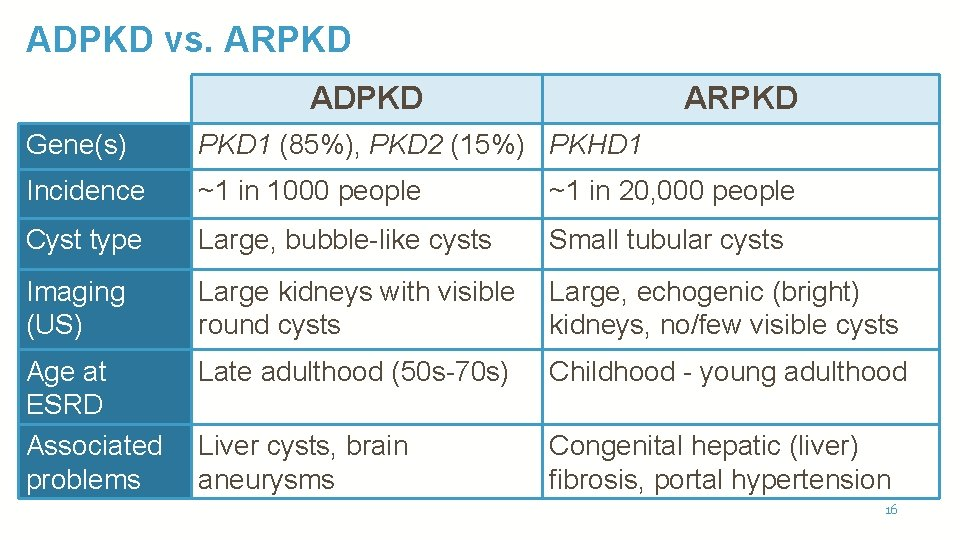It is classified into two distinct disorders: autosomal recessive PKD (ARPKD) and autosomal dominant PKD (ADPKD).
Epidemiology
ADPKD: The most common inherited cause of chronic kidney disease
Etiology
- ADPKD
- PKD1 on chromosome 16 (85% of cases)
- PKD2 on chromosome 4 (15% of cases)
- ARPKD
- Mutation in PKHD1 gene on chromosome 6
Mnemonic
Polycystic Kidney = 16 letters! = Chromosome 16
Pathophysiology
Formation and expansion of cysts in the renal cortex and medulla → compression of renal vessels with activation of the renin-angiotensin-aldosterone system (RAAS), ischemia, and destruction of the kidney parenchyma
Clinical features
ADPKD
- Symptom onset: occur after 30 years of age, but the disease may also manifest during childhood.
- Cysts develop over many years.
- Renal manifestations
- Gross hematuria
- Flank or abdominal pain
- The pain is often dull and persistent and is thought to be caused by stretching of the wall of a cyst or pressure on other organs when the kidneys and/or liver are very large.
- Recurrent urinary tract infections
- Nephrolithiasis
- Kidneys might be palpable and enlarged on abdominal exam (they are usually normal at birth)
- Signs of chronic kidney disease (e.g., hypertension, fluid overload, uremia)
- Extrarenal manifestations
- Multiple benign hepatic cysts (prevalence increases with age)
- Cysts may also occur in the pancreas, spleen, ovary, and testicles.
- Cerebral berry aneurysm (∼8%)
- The risk is higher in patients with a family history positive of ADPKD.
- May rupture and cause subarachnoid hemorrhage (the risk for growth and rupture is the same in patients with ADPKD as in the general population)
- Cardiovascular
- Signs of arterial hypertension (e.g., morning headaches) through increased renin production
- Heart valve defects (particularly mitral valve prolapse)
- Colon diverticula (diverticulosis)
ARPKD
- Symptom onset: Symptoms most commonly manifest in infancy or childhood.
- Renal manifestations
- Protruding abdomen (nontender abdominal mass) due to bilateral renal enlargement and/or hepatomegaly
- Chronic renal failure: frequently hematuria, proteinuria, and oliguria
- Severe in-utero renal impairment → oliguria in utero → maternal oligohydramnios → Potter sequence
- Extrarenal manifestation
- Hypertension
- Possibly related to the activation of RAAS and enhanced sodium retention.
- Liver involvement: congenital hepatic and portal fibrosis → progressive liver failure and portal hypertension
- Hypertension
Diagnostics
| Feature | ADPKD (Adult) | ARPKD (Infantile) |
|---|---|---|
| Gene | PKD1/PKD2 | PKHD1 |
| Onset | Adulthood (30-40s) | In Utero / Infancy |
| Presentation | HTN, flank pain, hematuria | Potter sequence, neonatal respiratory distress |
| Liver Disease | Hepatic cysts | Congenital hepatic fibrosis, portal HTN |
| Key Association | Berry aneurysms | Pulmonary hypoplasia |
| Prognosis | ESRD ~age 60 | High neonatal mortality; ESRD in childhood |
- ADPKD
- In adults: enlarged kidneys with multiple cysts bilaterally of varying sizes (anechoic masses)
- ARPKD
- Enlarged kidneys with multiple cysts bilaterally of equal size
